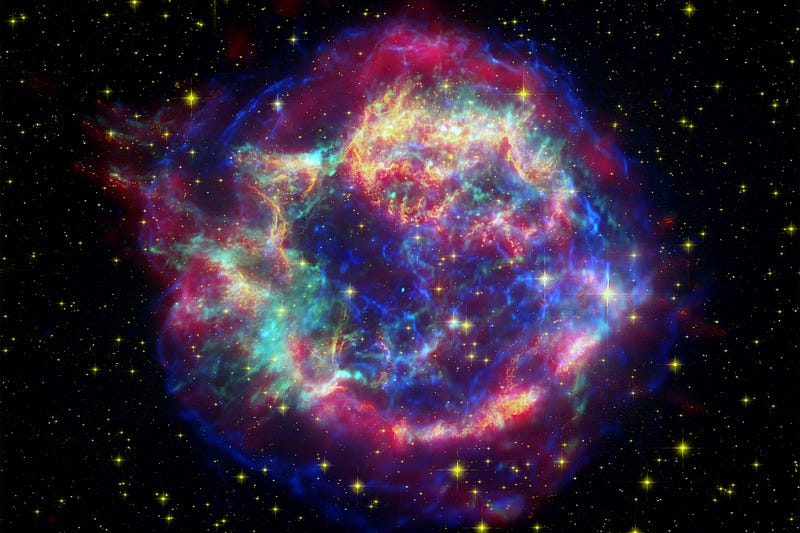A Fascinating Link Between Supernovae and Human Bipedalism
Written on
Chapter 1: Cosmic Events and Their Impact on Evolution
Space phenomena can significantly influence life on Earth. The most notorious example is the meteor strike that caused the extinction of a large portion of Earth's flora and fauna. However, recent theories propose that some cosmic events may have even weirder implications for our evolutionary history. A new study in the Journal of Geology posits that a sequence of ancient supernova explosions could have played a role in the development of bipedalism in our early ancestors.
This might sound outlandish at first. How could the explosion of distant stars contribute to the way humans walk? Let's explore this intriguing hypothesis.
Adrian Melott, an astrophysicist from the University of Kansas and the lead author of the study, has dedicated much of his research to understanding supernovae. A significant finding from a few years ago revealed iron-60 deposits scattered across the globe, suggesting that a specific cluster of supernovae erupted from a similar distance and timeframe. These deposits indicate that the cosmic rays from these explosions began reaching Earth approximately 8 million years ago, peaking around 2.6 million years ago. For Melott and his team, this timeline corresponds with activity originating about 123 light-years away in a region known as the Local Bubble, characterized by hot gas likely produced by a series of supernovae. The progenitor stars that exploded were likely nine times more massive than our sun.
“We wanted to investigate the potential consequences of these supernovae,” Melott explains.
The impact of supernovae on Earth has not been thoroughly explored. Initial studies, dating back to the 1950s, focused on whether nearby supernovae could have prompted mass extinction events. However, Melott's recent paper shifts focus to the environmental effects of more distantly located supernovae.
It stands to reason that such cosmic events would have some impact. Supernovae release cosmic rays, which can induce temperature fluctuations on Earth. In fact, these explosions produce cosmic rays with energies reaching up to a quadrillion volts—15 zeros! In contrast, typical cosmic rays rarely exceed a billion volts (nine zeros). “These are vastly more energetic than the cosmic rays we usually encounter,” Melott notes.
Melott and his co-author, Brian Thomas from Washburn University, hypothesized that these powerful cosmic rays might ionize particles throughout Earth's atmosphere, extending all the way to the surface. “That’s unusual,” Melott adds. “Normally, ionization dissipates at stratospheric levels. But these rays penetrate deeper, leading to increased cloud-to-ground lightning.” This heightened ionization creates more free electrons and ions, establishing a conductive pathway for lightning. Consequently, they estimate a potential increase of up to 50 times more lightning strikes as a direct result of these supernovae.
They ran computational models, and the results bolster their unconventional theory. Melott and Thomas suggest that the surge in lightning could have triggered numerous wildfires, evidenced by a rise in soot and carbon deposits from that era. These wildfires might have decimated forests in Northeast Africa, transforming them into grassier savannas. Recent theories propose that such environmental changes may have influenced the evolution of bipedalism in early hominids. With fewer trees, walking upright would have been a more efficient means of traversing the landscape, allowing early humans to spot predators lurking in the grass.
However, this theory faces challenges. Ashley Hammond, a biological anthropology curator at the American Museum of Natural History, remarks, “This perspective seems to overlook the fossil record.” Those familiar with the record assert that by 2.6 million years ago, bipedalism was already well established, having originated around 4.4 million years ago—two million years before the supernova activity peaked.
“Bipedalism is a very ancient trait,” Hammond points out. “It's one of the earliest hallmarks of hominid evolution. Tying it to events occurring 2.6 million years ago feels like a stretch.” If one were to connect supernovae to human evolution, it would be more logical to link them to the emergence of the Homo genus, which appears in the fossil record around 2.8 million years ago and was more prevalent from about 2 million years ago.
Moreover, the precise factors that led to the rise of bipedalism remain a topic of debate. “It's still a heavily contested subject,” Hammond notes. While the savannah hypothesis is discussed among scientists, questions linger about when African landscapes transitioned from wooded areas to grasslands, and how significantly wildfires contributed to this transformation.
Melott emphasizes that he and Thomas are not paleontologists. He considers their paper's ideas a “theoretical expectation,” viewing their findings as part of a broader effort to understand lightning formation, which he admits is “not well understood.” Ironically, this raises a crucial limitation of their research: without a solid understanding of how lightning initiates, it's uncertain whether the proposed link between supernovae and increased lightning strikes, capable of igniting vast wildfires, holds true. “Our hypothesis hinges on the idea that cosmic rays can seed lightning,” Melott states.
While their proposal draws an intriguing connection, the consensus remains: to validate whether supernovae in the Local Bubble influenced human bipedalism, more substantial evidence is necessary.
Section 1.1: The Role of Supernovae in Earth's History
Supernova remnants like Cassiopeia A provide insight into these cosmic events.

Section 1.2: Cosmic Rays and Their Potential Effects
The remarkable energy of cosmic rays from supernovae raises questions about their influence on Earth's environment and biological evolution.
Chapter 2: Investigating the Bipedalism Connection
The first video titled "Contemporary Core Collapse Supernova Theory" explores the mechanisms of supernova explosions and their implications for cosmic evolution.
The second video, "Finally! An Explanation for One of the Most Powerful Supernovae Ever Seen," delves into the significance of supernovae in understanding the universe's history and the mysteries of cosmic phenomena.